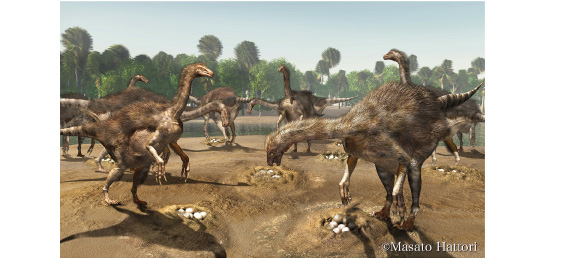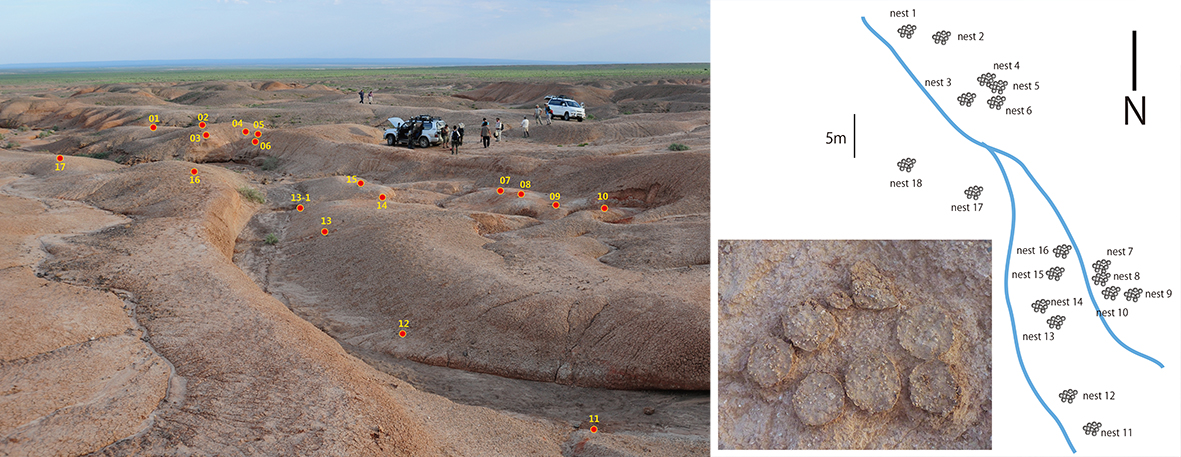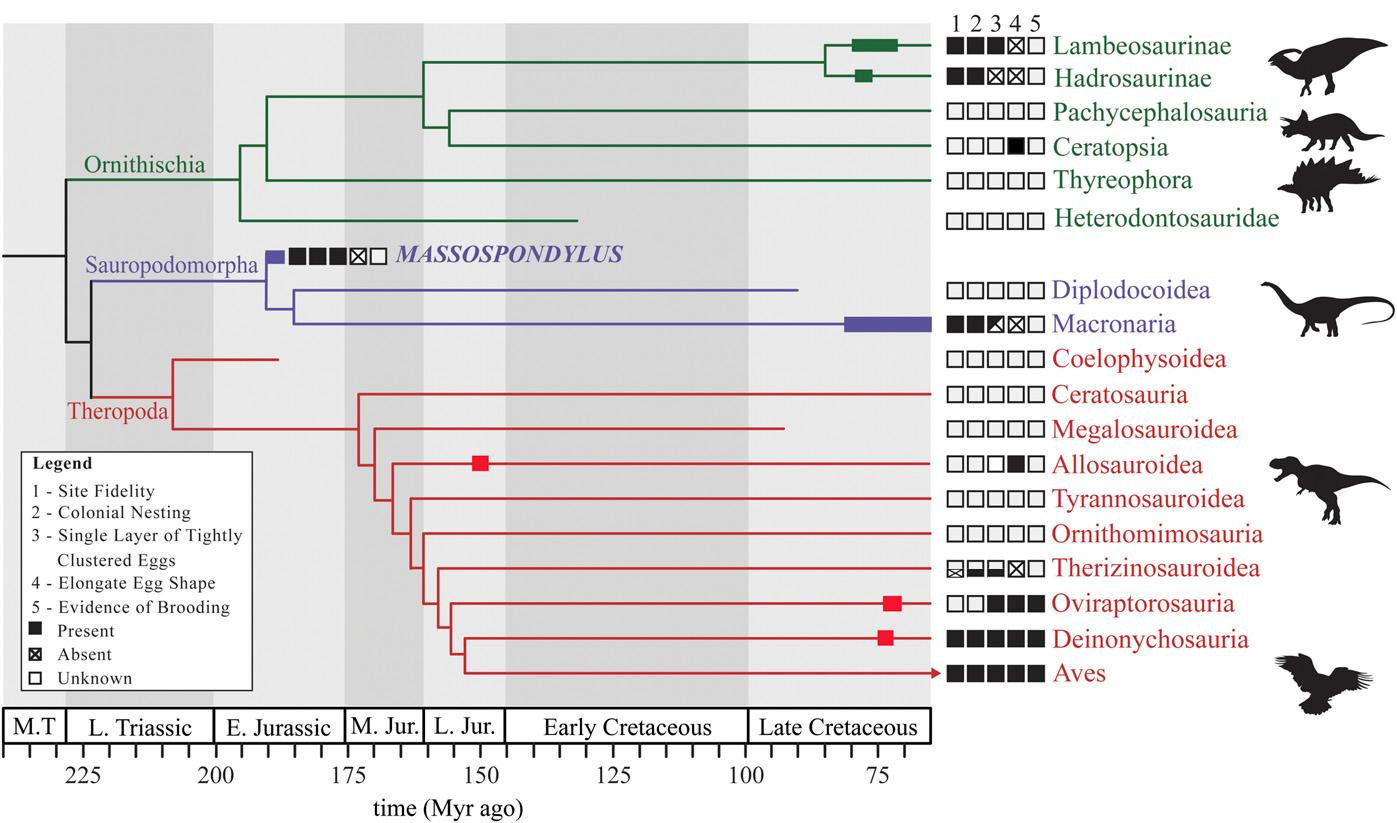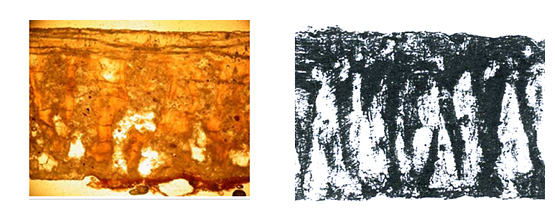First record of a dinosaur nesting colony from Mongolia reveals nesting behavior of therizinosauroids
Research Press Release | November 05, 2013
-
 Artistic reconstruction of colonial nesting site of therizinosaur dinosaurs from Mongolia by Masato Hattori
Artistic reconstruction of colonial nesting site of therizinosaur dinosaurs from Mongolia by Masato Hattori -
 Left, photo of the locality (red dots are nests); middle, a nest at the site; right, distribution map of nests in this study
Left, photo of the locality (red dots are nests); middle, a nest at the site; right, distribution map of nests in this study
| Press Release | |||
|---|---|---|---|
| Summary | Despite the richness of dinosaur eggs from Asia, colonies of egg nests are rarely found. Here we report a nesting colony of a theropod dinosaur from the early Late Cretaceous Javkhlant Formation in the eastern Gobi Desert of Mongolia, discovered in 2011. There are at least seventeen clutches of dendroothid eggs, ascribed to therizinosauroid dinosaurs, in a single stratigraphic horizon within an area of 22m x 52m. This is the first record of a dinosaur nesting colony from Mongolia and represents the largest known non-avian theropod colony. This nesting colony site suggests that therizinosaurs were gregarious and nested in colonies, and shows that colonial nesting was more widespread in dinosaurs than previously known. There is no evidence for brooding behavior for therizinosaurs unlike for other maniraptorans, such as oviraptorids, troodontids and birds. | ||
|
Background Information |
Javklant Formation Fossil eggs of dinosaurs and birds are commonly discovered from the Upper Cretaceous beds, mainly the Djadokhta, Baruungoyot, and Nemegt formations, in the western Gobi Desert, Mongolia, but dinosaur eggs from the eastern Gobi Desert are relatively rare. Some eggs and nests, including an isolated egg with a basal neoceratopsian dinosaur embryo (possibly Yamaceratops dorngobiensis), are reported from the Javkhlant Formation so far. Identification of eggs The eggshell is approximately 1.5 mm thick and has a rough outer surface without distinct ornamentation. Microscopic analyses of eggshells show dendrospherulithic shell units with a prolatocanaliculate pore system. These features, along with shell thickness and egg mass, suggest that the Javkhlant eggs belong to the Dendroolithidae, an egg type previously ascribed to therizinosaurs. Thus, this discovery reveals the first recorded occurrence of therizinosaur eggs from the eastern Gobi. Records of dinosaur nesting colonies Colonial nesting sites were previously known only in hadrosaurs, sauropodomorphs, deinonychosaurs, and birds among Dinosauria. Below is a time-calibrated cladogram of Dinosauria from Reisz et al. (2012), showing the known distribution of selected reproductive characters and the known distribution of fossil nests (thick bars), with data for Therizinosauroidea from this study (in the lower portion of square boxes).  A time-calibrated cladogram of Dinosauria from Reisz et al. (2012), showing the known distribution of selected reproductive characters and the known distribution of fossil nests (thick bars), with data for Therizinosauroidea from this study (in the lower portion of square boxes). |
||
|
Comments from Authors |
Yoshitsugu Kobayashi, Associate Professor, Hokkaido University “This world’s largest non-avian theropod colony reveals the nesting behaviors of enigmatic dinosaurs, called therizinosaurids, and also indicates that nesting behaviors of dinosaurs were more diverse than previously thought.” Yuong-Nam Lee, Director, Geological Museum, Korea Institute of Geoscience and Mineral Resources “Based on our discovery, we can expect that more dinosaur colonial nesting grounds will be found in Mongolia in the near future as many dinosaur tracks and trackways have been recently found in the Gobi Desert.” Darla Zelenitsky, Assistant Professor, University of Calgary “These dinosaurs may have nested in colonies to protect their nests against predators, a strategy also retained by the living descendents of dinosaurs — birds.” “Our discovery of this fossil site shows that the behavior of nesting in colonies was more common among dinosaurs than previously known.” |
||
| Inquiries |
Yoshitsugu Kobayashi, Associate Professor, Hokkaido University Museum TEL: & FAX: +81-11-706-4730 e-mail: ykobayashi@museum.hokudai.ac.jp |
||
|
Japanese Link |
http://www.hokudai.ac.jp/news/131102-terijino-pres.pdf | ||
|
News Article |
http://www.huffingtonpost.com/2013/11/05/dinosaur-nests-mongolia-eggs-big-clawed_n_4217885.html | ||

